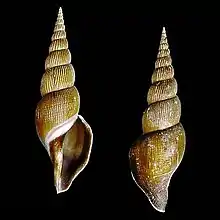Calliotectum
Calliotectum is a genus of sea snails, marine gastropod mollusks in the family Volutidae.[1]
| Calliotectum | |
|---|---|
 | |
| Shell of Calliotectum egregium | |
| Scientific classification | |
| Domain: | Eukaryota |
| Kingdom: | Animalia |
| Phylum: | Mollusca |
| Class: | Gastropoda |
| Subclass: | Caenogastropoda |
| Order: | Neogastropoda |
| Superfamily: | Volutoidea |
| Family: | Volutidae |
| Genus: | Calliotectum Dall, 1890 |
| Synonyms[1] | |
| |
The genus was first described by William Healey Dall in 1890.[1][2]
Description
The shell shows a dark vernicose periostracum. There is no differentiated siphonal canal, anal sulcus or fasciole. The shell is axially ribbed. The columella is thin and twisted. The axis is impervious. The outer lip is simple, arcuate, thin, not internally lirate. The operculum is like that of Fusinus, but arcuate. The animal is blind, without radula or poison gland. Type species: Calliotectum vernicosum Dall, 1890.
Distribution
Species of the genus are found off Taiwan, in the East China Sea, Vanuatu, Indonesia, Loyalty Islands, New Caledonia, Philippines, Eastern Pacific, Galapagos Islands, Lubang Island, Wallis and Futuna, Kermadec Islands, Chesterfield Isles, East China Sea, Indonesia, in the Arafura Sea, and off the northern and western coasts of Australia.[3]
Species
Species within the genus Calliotectum include:
- Calliotectum dalli (Bartsch, 1942)[4]
- Calliotectum egregium Bouchet & Poppe, 1995[5]
- Calliotectum mirabile (Clench & Aguayo, 1941)[6]
- Calliotectum piersonorum Bouchet & Poppe, 1995[7]
- Calliotectum smithi (Bartsch, 1942)[8]
- Calliotectum tibiaeforme (Kuroda, 1931)[9]
- Calliotectum vernicosum Dall, 1890[10]
References
- Calliotectum Dall, 1890. Retrieved through: World Register of Marine Species on 25 April 2010.
- Dall, W.H. (1890). "Scientific results of the explorations of the U.S. Fish Commission steamer "Albatross" no. 7. Preliminary report of the collection of Mollusca and Brachiopoda obtained in 1887-88". Proceedings of the United States National Museum. 12 (773): 219-362 [304].
- "Australian Faunal Directory: Calliotectum". biodiversity.org.au. Retrieved 2022-01-26.
- Calliotectum dalli (Bartsch, 1942). Retrieved through: World Register of Marine Species on 25 April 2010.
- Calliotectum egregium Bouchet & Poppe, 1995. Retrieved through: World Register of Marine Species on 25 April 2010.
- Calliotectum mirabile (Clench & Aguayo, 1941). Retrieved through: World Register of Marine Species on 25 April 2010.
- Calliotectum piersonorum Bouchet & Poppe, 1995. Retrieved through: World Register of Marine Species on 25 April 2010.
- Calliotectum smithi (Bartsch, 1942). Retrieved through: World Register of Marine Species on 25 April 2010.
- Calliotectum tibiaeforme (Kuroda, 1931). Retrieved through: World Register of Marine Species on 25 April 2010.
- Calliotectum vernicosum Dall, 1890. Retrieved through: World Register of Marine Species on 25 April 2010.
- Bail P. & Poppe G.T. 2001. A conchological iconography: a taxonomic introduction of the recent Volutidae. ConchBooks, Hackenheim. 30 pp, 5 pl.